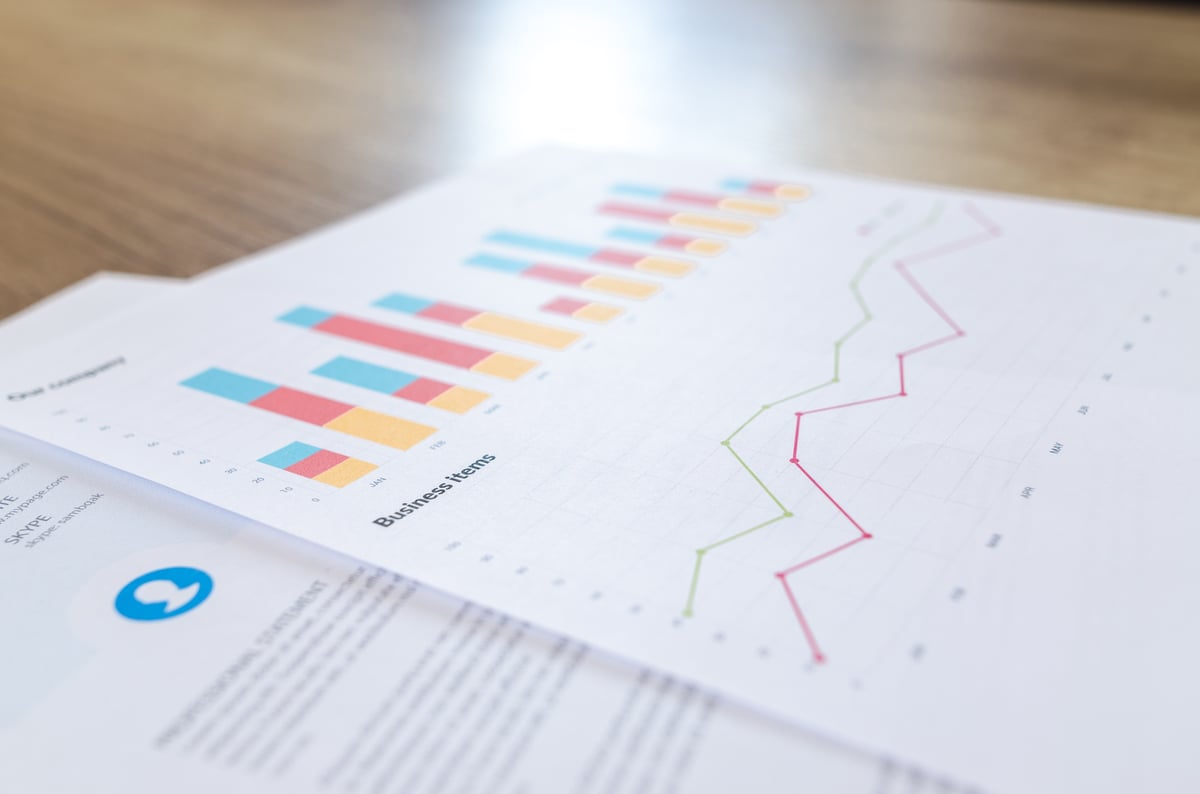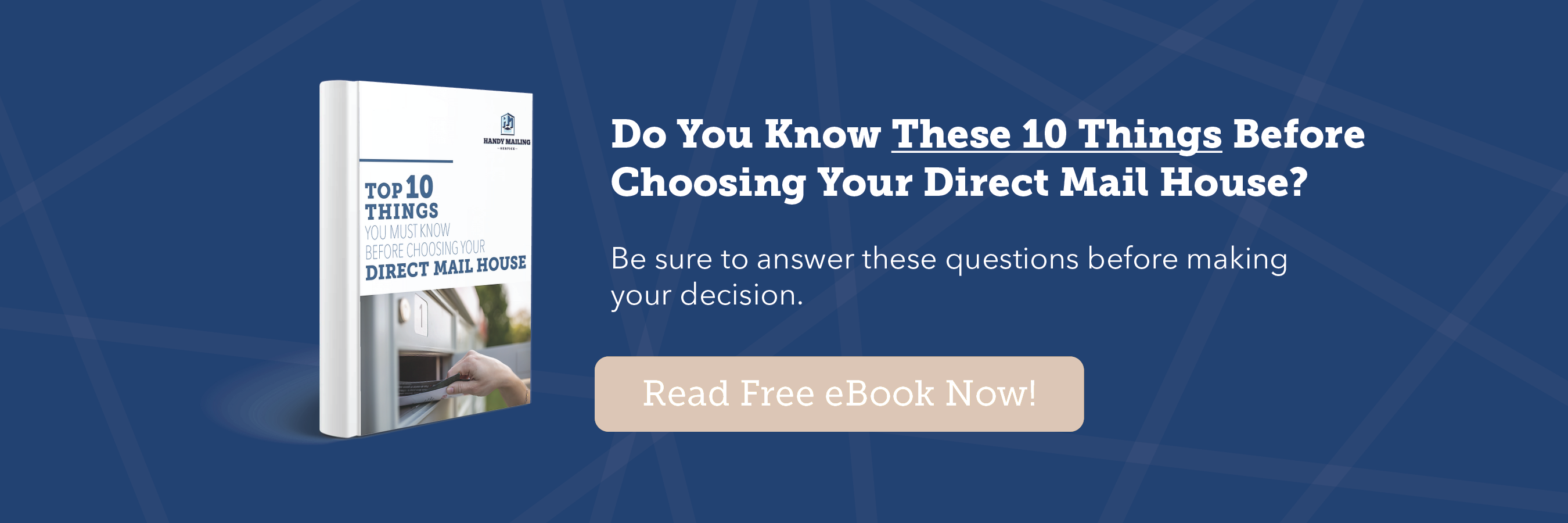As a mail house that sends out around 23 million pieces a year, we see a lot of things. We see successful mailers, and some that are not so successful. And here’s the thing, each successful mailer uses a different strategy.
Unfortunately, there’s not a secret formula that works for every mail piece. But, I’m going to share with you a strategy that is on the rise and will see continued success in the future.
In this article, you’ll learn how to improve your direct mail results with the use of thoughtful, strategic personalization.
Download our free eBook to find out what you need to know about choosing your direct mail house.
Personalization
Before diving into personalization, let’s define what that means exactly. Personalization is giving someone a special experience, by including specific information that is relevant to them. This can be influenced by the text they read, the images they see, or the “personal” information about them, that is included in the message.
All around us, we’re experiencing cases of personalization. For example, while streaming your favorite show, you get interrupted by an annoying commercial that relates to one of your favorite online retail stores. Or the sidebar ad, advertising some of the products you recently Googled or looked at. The sponsored Instagram ad selling the sunglasses that your favorite celebrity was wearing in their latest post. But here’s the thing, although personalized to us, these ads don’t make us feel special or valued. We figure they’re part of some Google algorithm.
What impacts us most is when someone uses personalization to give us a special experience.
What impacts us most is when someone uses personalization to give us a special experience. It’s when we notice a product at the “perfect time.” Or feel like someone is talking directly to us, even though we know we’re one of 1,000 prospects. Being able to provide these special experiences to your customers, is going to lead you to success in the upcoming year.
A Meaningful Experience
Transitioning now to personalization in the direct mail world, what kind of impact can it have? There’s three specific ways that you’ll see positive results with effective use.
- Improved open rates
- Higher conversion rates
- Better targeted offers
Improved Open Rates
If you have any experience with direct mail, you probably know this absolute truth. Your sales piece will never sell... if it never gets read.
Gone are the days of people seeing an envelope with their name on it and thinking it’s specifically for them. No, we’re all investigators now. We examine the outside. The fonts, the post mark, the weight, size, and anything else we can use to get a better idea of what it is. People are more cautious and distrusting than ever of “junk mail.” It’s critical to find ways to pass the trust test, and get opened before being pitched in the trash.
This is where personalization works its magic. It earns the recipients trust. They see their first name scribbled on the envelope in the teaser copy. Or a detail specific to them included in the big headline on the outside. “Wow, this has to be for me if they know I have an in-ground pool in my backyard.” By including this small aspect of personalization, you’ve walked past their guard dog, patted it on the head, and knocked on the front door. Already, your chances of success have skyrocketed.
Higher Conversion Probability
Now’s the time to deliver the targeted and persuasive message. You’ve earned their trust this far, show them it’s worth their time. Address a problem they’re dealing with and show how you can solve that for them. By caring about a struggle they’re experiencing, you can be the solution they’ve been looking for. So when it comes to converting, what can you do to improve the chances of them taking the leap? By creating a relevant conversion path, specific to them.
This starts by understanding who they are and what their preferred method is. If you are marketing to someone who is under the age of 40 or so, then driving them online or to a specific landing page can be an effective method. But, if your audience is older and over the age of 60, it’s critical to realize they’re not going to be the most tech savvy. Take this into account to provide the easiest and most personalized approach. It might be best for them to call a number to order instead. There can’t be a one size fits all conversion path if your audience is different in age and demographics. Give them the path that’s easiest for them to take action on.
Better Targeted Offers
To convert prospects into customers, it takes quality targeted offers. With technology today, you can provide highly targeted offers that will be most effective when presented to the right prospects. You don’t have to send everybody the same offer. You can personalize it by percentage, dollars off, expiration date, and more. Let’s look at an example for how this can work.
You own a dry cleaning business and are sending out a total of 10,000 postcards to a mix of customers and prospects. With personalization, you can make sure that each type of recipients receives the correct offer.
Recipient A: If they’re a returning customer who is bringing in their clothes on a weekly basis, you can offer them 15% off their next purchase. Because, you know they’ll probably be back regardless of the coupon.
Recipient B: This is a customer who hasn’t been in for over six months and you’re trying to win them back into the store. On their postcard, include a 30% coupon to try to earn their business back.
Recipient C: This is a prospect who has yet to make a purchase with you. Offer them 50% off their first order with you to make it as risk-free as possible.
But here’s what so great about personalization. All three recipients are receiving the same postcard with the same artwork. The only difference is, the offers cater to what’s going to be most effective for each individual.
You can do this with your next campaign too. Instead of changing the discount percentage, you can change your call to action. For version one, have all recipients make an appointment by calling a phone number. Version two recipients can schedule their appointments online by visiting the URL you’ve provided. By testing these different options, you can learn which call to action is most profitable.
Using Details to Your Advantage
Often we see direct mail users include a first name field in a personalized letter and stop there. Now while that can be useful, you might be selling yourself short by not using the rest of the knowledge you have. In your customer database, what are some other fields of information you have on your customer? These might be location, recently purchased items, date of last purchase, total amount spent, and more. Have you thought about including any of these in your sales piece?
Instead of leaving it at Dear First Name, how can you work in other fields? The first idea that came to mind is including the most recent purchase date. How about this for a headline?
John, We Haven’t Seen You Since July… Was It Something We Did?
My guess is John’s going to feel like they wrote this sales letter or sent this postcard just for him. He probably didn’t realize that it had been that long since he last purchased something. And now, his interest in your new product or service has been piqued. Does this example spark an idea in your head of what you can do next?

Be Intentional With Your Recipients
As they say, “with great power comes great responsibility.” Here’s what I don’t what to happen. You read this article, quickly open your sales letter Word doc, then proceed to insert 27 variable fields into your next letter.
Including personalization fields for the sake of it is going to be 100% ineffective. To use it to your advantage, takes a bit of thought and strategy. The best sales pieces are ones that find ways to seamlessly include bits of personalization where necessary. You can’t force a square peg into a round hole. If you permeate your sales piece with too much information, your recipient is going to sniff that out immediately. It’s not just about what information you include, but how you include it. This can either aid or hinder the message you’re sending. Sometimes, that means leaving out a field if it doesn’t provide value to your piece.
It all comes down to this: have a developed strategy with whatever you decide to do. Take the time to plan everything out instead of adding to it as you go along. You’re not standing in line at Chipotle. You’re spending your hard earned dollars, trying to accomplish a difficult task.
If you do your due diligence ahead of time and find ways to use thoughtful personalization, 2019 is going to be your most successful year yet!



